Page 84 of 157
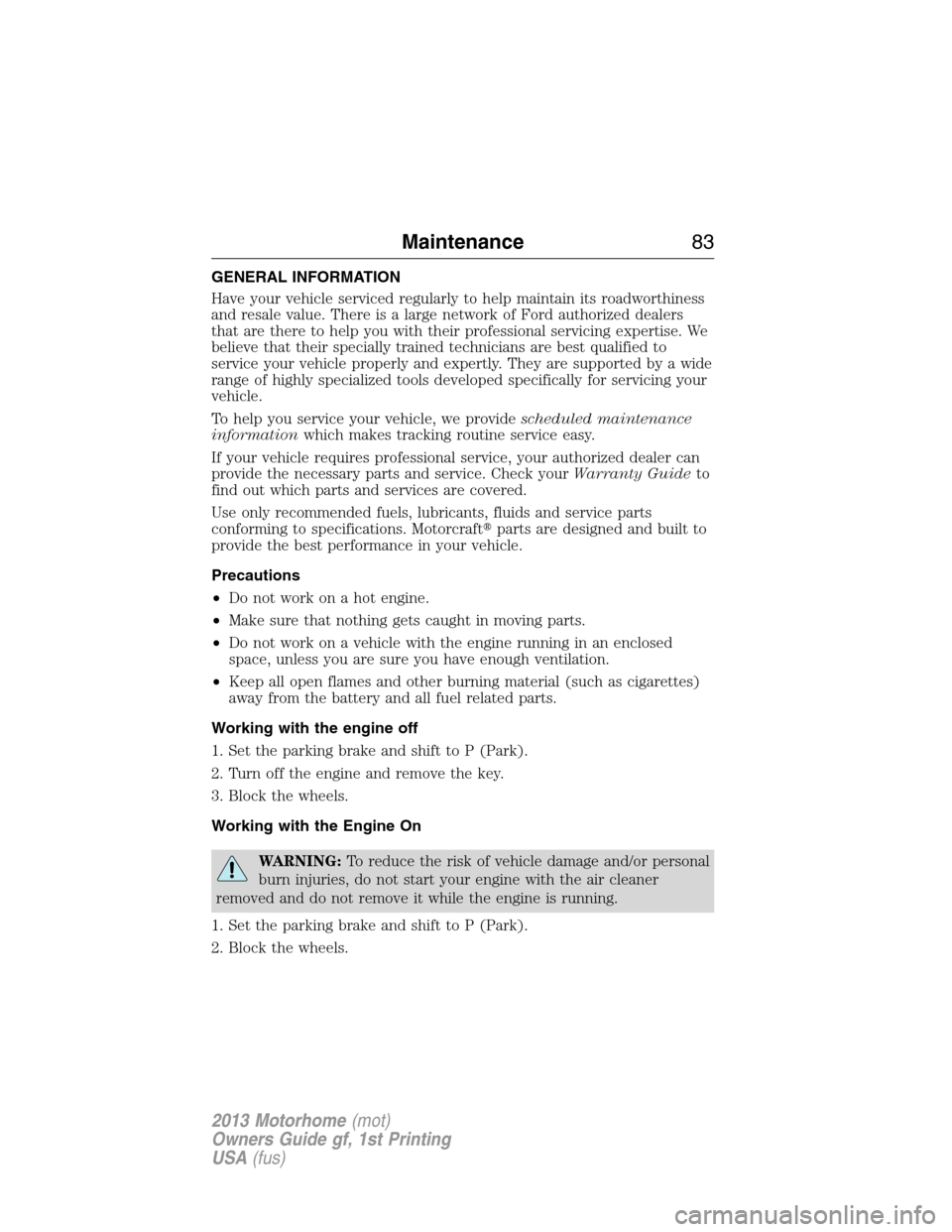
GENERAL INFORMATION
Have your vehicle serviced regularly to help maintain its roadworthiness
and resale value. There is a large network of Ford authorized dealers
that are there to help you with their professional servicing expertise. We
believe that their specially trained technicians are best qualified to
service your vehicle properly and expertly. They are supported by a wide
range of highly specialized tools developed specifically for servicing your
vehicle.
To help you service your vehicle, we providescheduled maintenance
informationwhich makes tracking routine service easy.
If your vehicle requires professional service, your authorized dealer can
provide the necessary parts and service. Check yourWarranty Guideto
find out which parts and services are covered.
Use only recommended fuels, lubricants, fluids and service parts
conforming to specifications. Motorcraft�parts are designed and built to
provide the best performance in your vehicle.
Precautions
•Do not work on a hot engine.
•Make sure that nothing gets caught in moving parts.
•Do not work on a vehicle with the engine running in an enclosed
space, unless you are sure you have enough ventilation.
•Keep all open flames and other burning material (such as cigarettes)
away from the battery and all fuel related parts.
Working with the engine off
1. Set the parking brake and shift to P (Park).
2. Turn off the engine and remove the key.
3. Block the wheels.
Working with the Engine On
WARNING:To reduce the risk of vehicle damage and/or personal
burn injuries, do not start your engine with the air cleaner
removed and do not remove it while the engine is running.
1. Set the parking brake and shift to P (Park).
2. Block the wheels.
Maintenance83
2013 Motorhome(mot)
Owners Guide gf, 1st Printing
USA(fus)
Page 85 of 157
UNDER HOOD OVERVIEW
6.8L V10 engine
1. Engine coolant reservoir
2. Engine oil filler cap
3. Automatic transmission fluid dipstick
4. Power distribution box
5. Air filter assembly
6. Engine oil dipstick
7. Brake fluid reservoir
8. Power steering fluid reservoir
12345768
84Maintenance
2013 Motorhome(mot)
Owners Guide gf, 1st Printing
USA(fus)
Page 86 of 157
6.8L V10 engine (commercial stripped chassis)
1. Engine coolant reservoir
2. Engine oil filler cap
3. Automatic transmission fluid dipstick
4. Power distribution box
5. Engine oil dipstick
6. Brake fluid reservoir
7. Air filter assembly
8. Power steering fluid reservoir
12345678
Maintenance85
2013 Motorhome(mot)
Owners Guide gf, 1st Printing
USA(fus)
Page 92 of 157
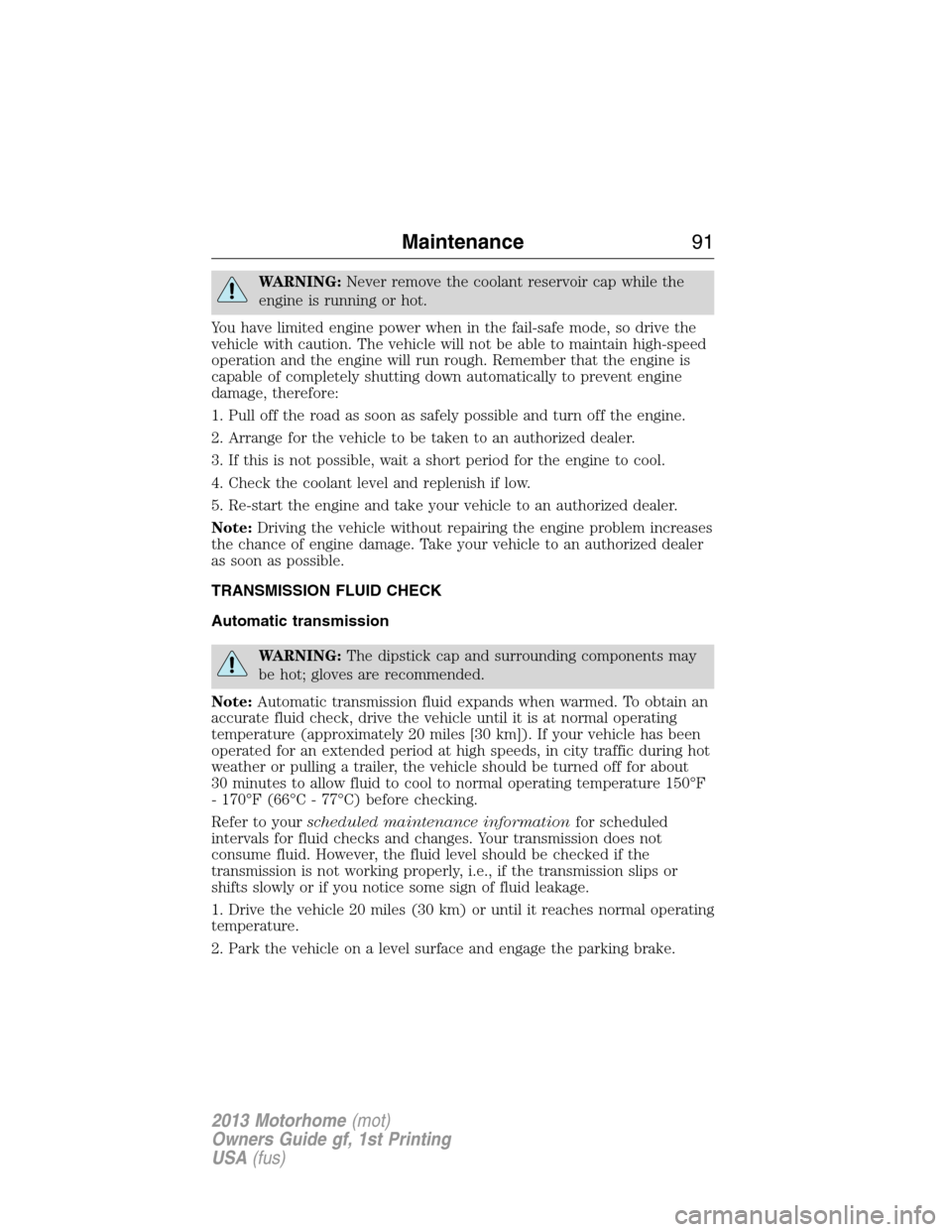
WARNING:Never remove the coolant reservoir cap while the
engine is running or hot.
You have limited engine power when in the fail-safe mode, so drive the
vehicle with caution. The vehicle will not be able to maintain high-speed
operation and the engine will run rough. Remember that the engine is
capable of completely shutting down automatically to prevent engine
damage, therefore:
1. Pull off the road as soon as safely possible and turn off the engine.
2. Arrange for the vehicle to be taken to an authorized dealer.
3. If this is not possible, wait a short period for the engine to cool.
4. Check the coolant level and replenish if low.
5. Re-start the engine and take your vehicle to an authorized dealer.
Note:Driving the vehicle without repairing the engine problem increases
the chance of engine damage. Take your vehicle to an authorized dealer
as soon as possible.
TRANSMISSION FLUID CHECK
Automatic transmission
WARNING:The dipstick cap and surrounding components may
be hot; gloves are recommended.
Note:Automatic transmission fluid expands when warmed. To obtain an
accurate fluid check, drive the vehicle until it is at normal operating
temperature (approximately 20 miles [30 km]). If your vehicle has been
operated for an extended period at high speeds, in city traffic during hot
weather or pulling a trailer, the vehicle should be turned off for about
30 minutes to allow fluid to cool to normal operating temperature 150°F
- 170°F (66°C - 77°C) before checking.
Refer to yourscheduled maintenance informationfor scheduled
intervals for fluid checks and changes. Your transmission does not
consume fluid. However, the fluid level should be checked if the
transmission is not working properly, i.e., if the transmission slips or
shifts slowly or if you notice some sign of fluid leakage.
1. Drive the vehicle 20 miles (30 km) or until it reaches normal operating
temperature.
2. Park the vehicle on a level surface and engage the parking brake.
Maintenance91
2013 Motorhome(mot)
Owners Guide gf, 1st Printing
USA(fus)
Page 93 of 157
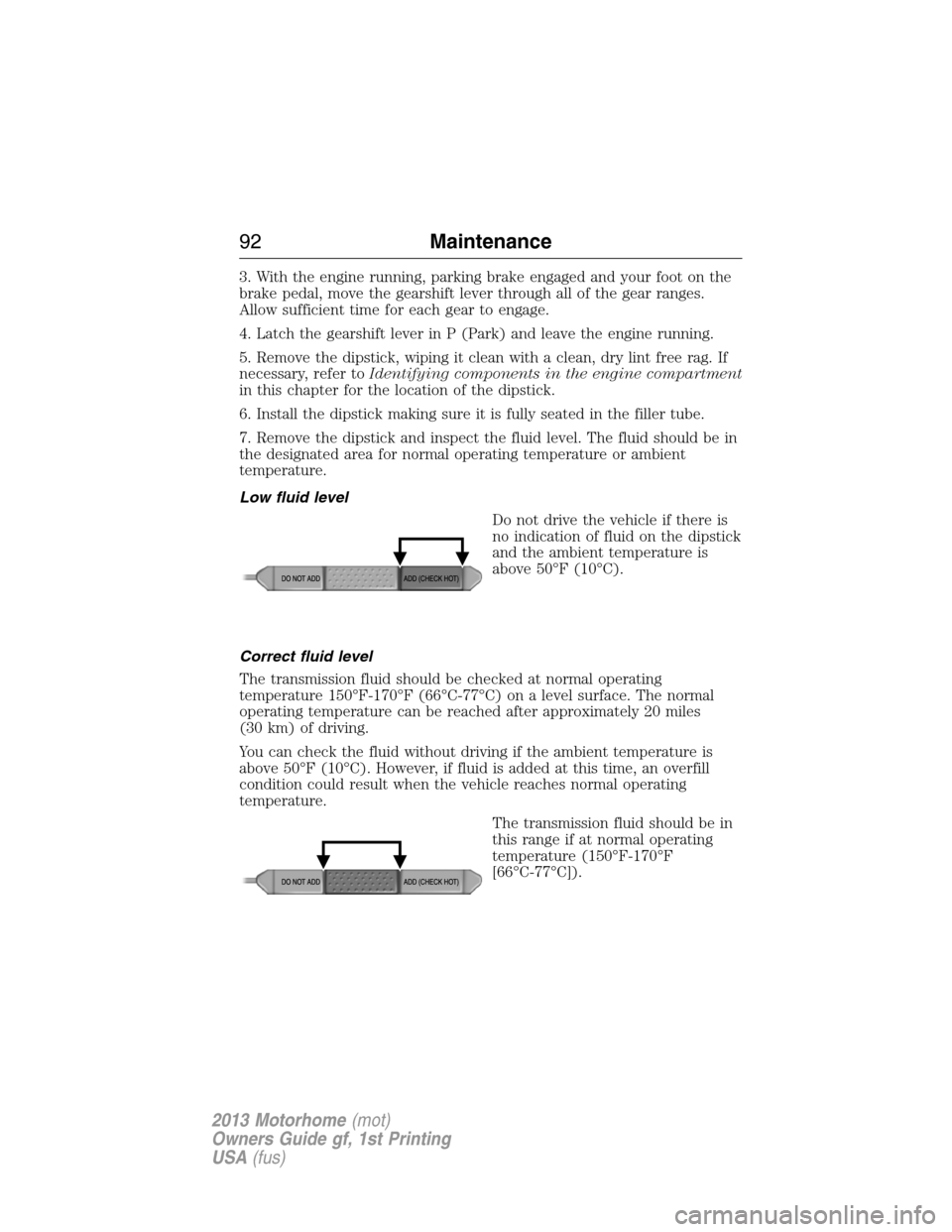
3. With the engine running, parking brake engaged and your foot on the
brake pedal, move the gearshift lever through all of the gear ranges.
Allow sufficient time for each gear to engage.
4. Latch the gearshift lever in P (Park) and leave the engine running.
5. Remove the dipstick, wiping it clean with a clean, dry lint free rag. If
necessary, refer toIdentifying components in the engine compartment
in this chapter for the location of the dipstick.
6. Install the dipstick making sure it is fully seated in the filler tube.
7. Remove the dipstick and inspect the fluid level. The fluid should be in
the designated area for normal operating temperature or ambient
temperature.
Low fluid level
Do not drive the vehicle if there is
no indication of fluid on the dipstick
and the ambient temperature is
above 50°F (10°C).
Correct fluid level
The transmission fluid should be checked at normal operating
temperature 150°F-170°F (66°C-77°C) on a level surface. The normal
operating temperature can be reached after approximately 20 miles
(30 km) of driving.
You can check the fluid without driving if the ambient temperature is
above 50°F (10°C). However, if fluid is added at this time, an overfill
condition could result when the vehicle reaches normal operating
temperature.
The transmission fluid should be in
this range if at normal operating
temperature (150°F-170°F
[66°C-77°C]).
92Maintenance
2013 Motorhome(mot)
Owners Guide gf, 1st Printing
USA(fus)
Page 95 of 157
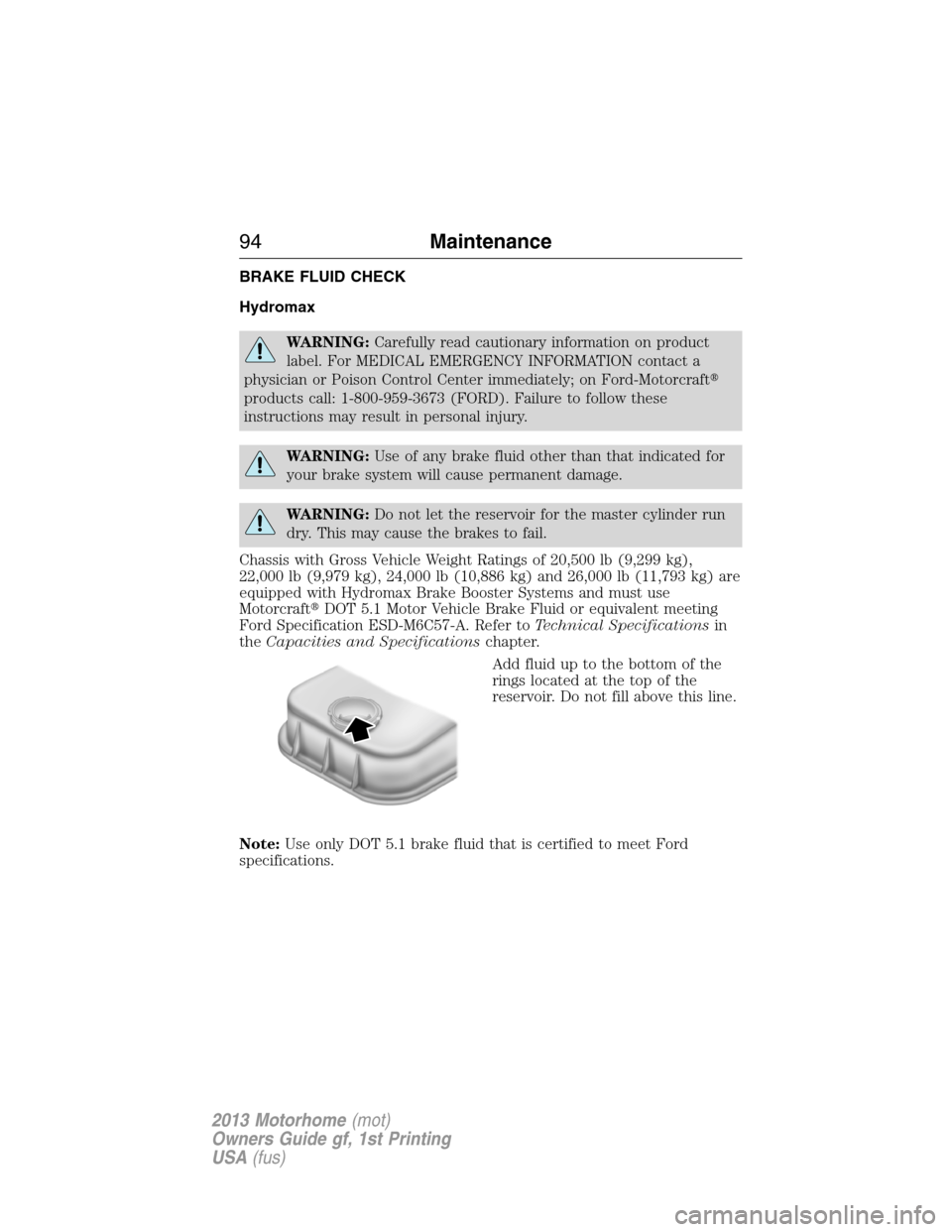
BRAKE FLUID CHECK
Hydromax
WARNING:Carefully read cautionary information on product
label. For MEDICAL EMERGENCY INFORMATION contact a
physician or Poison Control Center immediately; on Ford-Motorcraft�
products call: 1-800-959-3673 (FORD). Failure to follow these
instructions may result in personal injury.
WARNING:Use of any brake fluid other than that indicated for
your brake system will cause permanent damage.
WARNING:Do not let the reservoir for the master cylinder run
dry. This may cause the brakes to fail.
Chassis with Gross Vehicle Weight Ratings of 20,500 lb (9,299 kg),
22,000 lb (9,979 kg), 24,000 lb (10,886 kg) and 26,000 lb (11,793 kg) are
equipped with Hydromax Brake Booster Systems and must use
Motorcraft�DOT 5.1 Motor Vehicle Brake Fluid or equivalent meeting
Ford Specification ESD-M6C57-A. Refer toTechnical Specificationsin
theCapacities and Specificationschapter.
Add fluid up to the bottom of the
rings located at the top of the
reservoir. Do not fill above this line.
Note:Use only DOT 5.1 brake fluid that is certified to meet Ford
specifications.
94Maintenance
2013 Motorhome(mot)
Owners Guide gf, 1st Printing
USA(fus)
Page 96 of 157
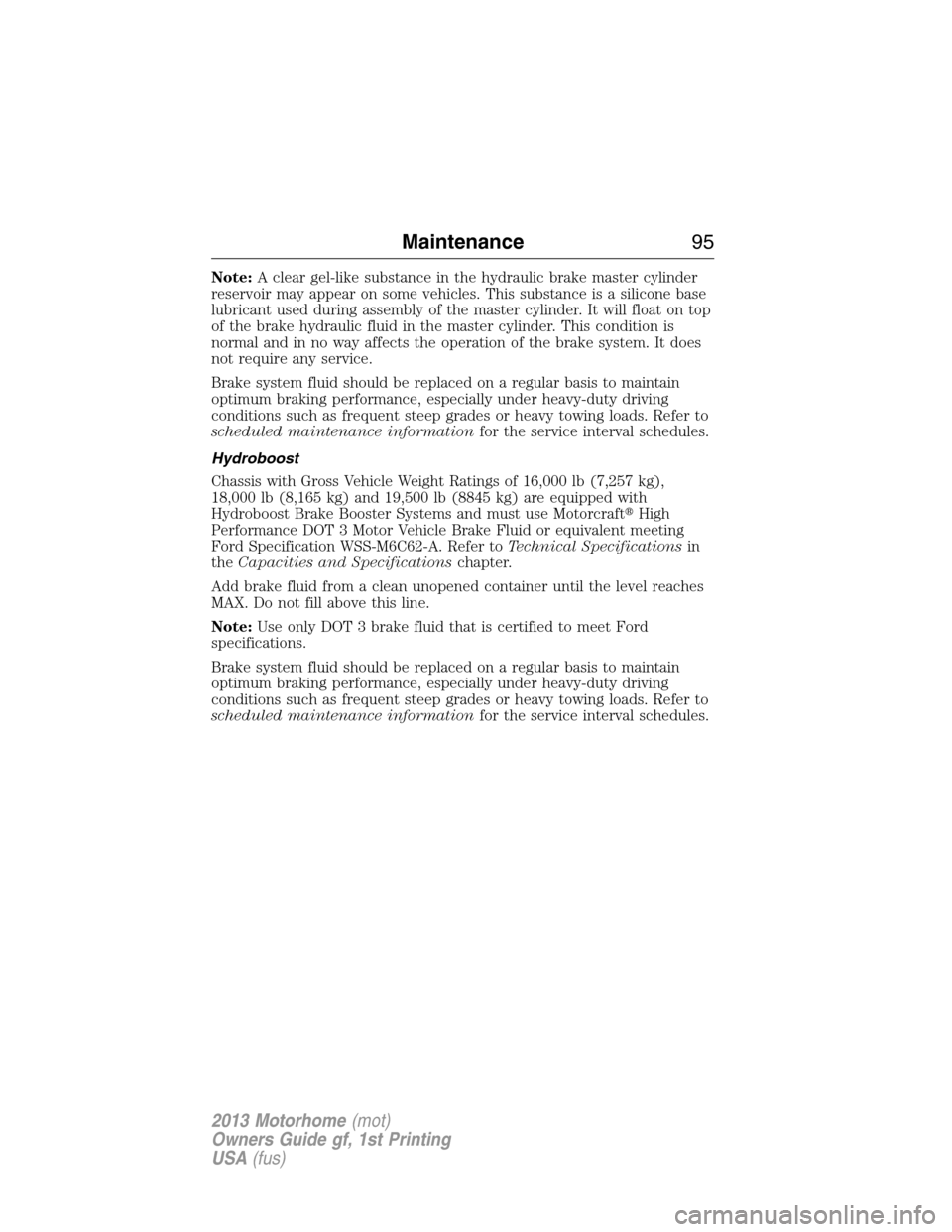
Note:A clear gel-like substance in the hydraulic brake master cylinder
reservoir may appear on some vehicles. This substance is a silicone base
lubricant used during assembly of the master cylinder. It will float on top
of the brake hydraulic fluid in the master cylinder. This condition is
normal and in no way affects the operation of the brake system. It does
not require any service.
Brake system fluid should be replaced on a regular basis to maintain
optimum braking performance, especially under heavy-duty driving
conditions such as frequent steep grades or heavy towing loads. Refer to
scheduled maintenance informationfor the service interval schedules.
Hydroboost
Chassis with Gross Vehicle Weight Ratings of 16,000 lb (7,257 kg),
18,000 lb (8,165 kg) and 19,500 lb (8845 kg) are equipped with
Hydroboost Brake Booster Systems and must use Motorcraft�High
Performance DOT 3 Motor Vehicle Brake Fluid or equivalent meeting
Ford Specification WSS-M6C62-A. Refer toTechnical Specificationsin
theCapacities and Specificationschapter.
Add brake fluid from a clean unopened container until the level reaches
MAX. Do not fill above this line.
Note:Use only DOT 3 brake fluid that is certified to meet Ford
specifications.
Brake system fluid should be replaced on a regular basis to maintain
optimum braking performance, especially under heavy-duty driving
conditions such as frequent steep grades or heavy towing loads. Refer to
scheduled maintenance informationfor the service interval schedules.
Maintenance95
2013 Motorhome(mot)
Owners Guide gf, 1st Printing
USA(fus)
Page 97 of 157
Parking brake fluid
Check the fluid level only if there is
visible signs of fluid leakage. If
necessary, fill the parking brake
assembly to the bottom of the filler
plug hole (B) (located on the driver
side of the transmission). Refer to
Technical specificationsin the
Capacities and Specifications
chapter for the proper fluid type.
Note:Do not fill the parking brake through the vent plug (A) (located
on top of the transmission).
POWER STEERING FLUID CHECK
1. Start the engine and let it run until it reaches normal operating
temperature (the engine coolant temperature gauge indicator will be
near the center of the normal area between H and C).
2. While the engine idles, turn the steering wheel left and right several
times.
3. Turn the engine off.
A
B
96Maintenance
2013 Motorhome(mot)
Owners Guide gf, 1st Printing
USA(fus)